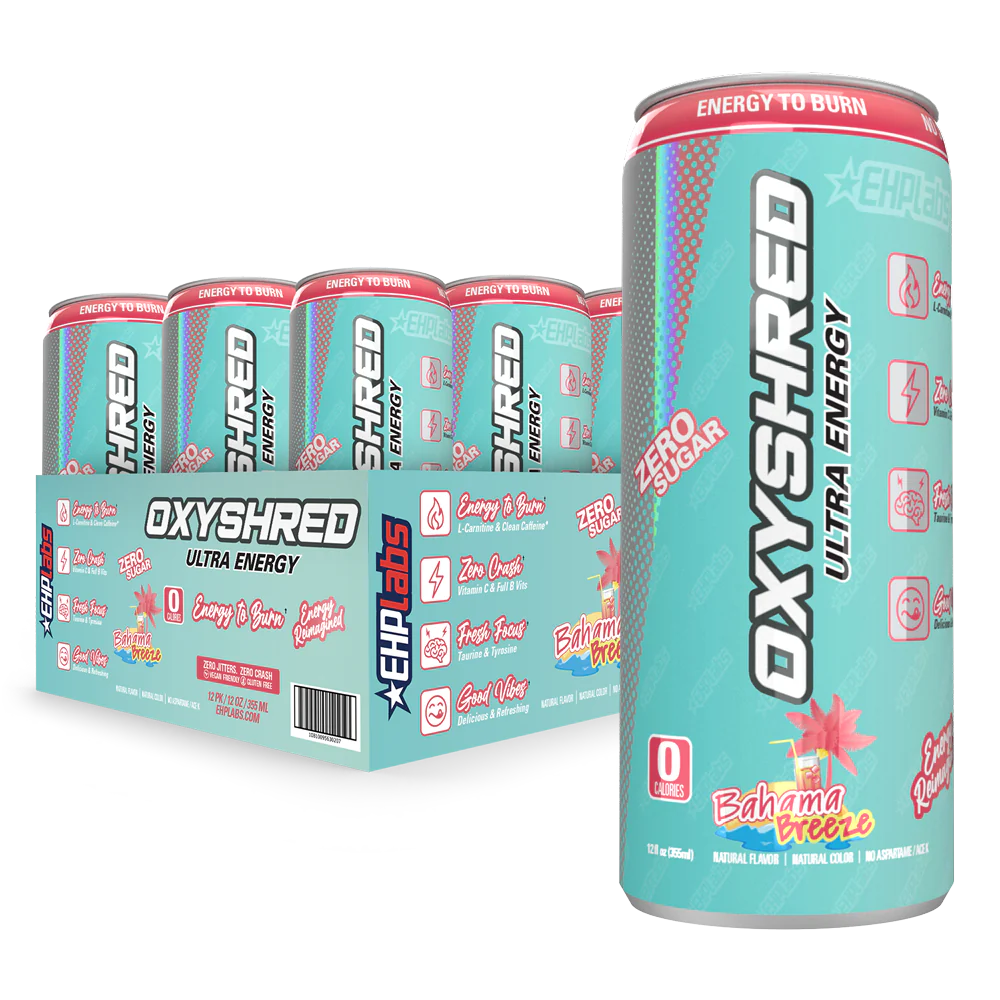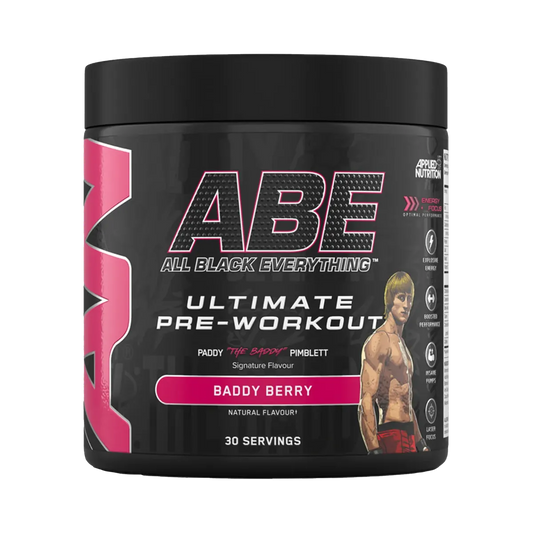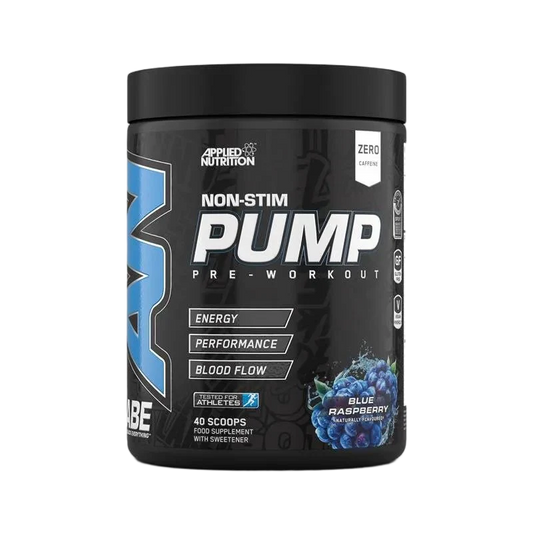Walk into any gym, and you’ll hear it: the crack of a shaker bottle, the scoop hitting the tub, the almost ritualistic gulp of bright neon liquid before the first set. Pre-workouts are one of the most popular supplement categories in the UK — and they’re not going anywhere. But with that popularity comes an important question: are they safe to take long term, or are we all just buzzing on borrowed energy?
This blog is here to strip away the marketing hype and dig into the science (and the side effects) of pre-workouts. We’ll also look at smart alternatives, like creatine, electrolytes, and stim-free options, that keep you training at your best without the dreaded burnout.
Is Pre-Workout Safe for Long-Term Use?
The short answer: it depends on what’s inside your pre-workout and how you’re using it.
Most pre-workouts, like Applied Nutrition ABE Pre-Workout, are loaded with caffeine (200–350mg per scoop), beta-alanine, creatine, and nitric oxide boosters (like citrulline malate). None of these ingredients are inherently unsafe, but the issue arises when they’re taken every single day without a break.
-
Caffeine tolerance builds fast. Within two weeks of daily use, you’ll feel less of a kick from the same dose, meaning you’ll either up the scoops (dangerous) or feel “flat” on days without it.
-
Sleep can take a hit. Even if you train in the morning, a heavy caffeine load can linger in your system, affecting your deep sleep cycles at night.
-
Digestion and jitters. Beta-alanine tingles might be harmless, but excess stimulants can cause anxiety, stomach issues, and dehydration over time.
👉 The verdict: pre-workout isn’t inherently dangerous long term, but the way you use it is what matters. Cycling on and off, choosing stim-free options like Applied Nutrition ABE Pump, and pairing with basics like BetterYou Magnesium Water (to counter nervous system stress) keeps things balanced.

Is It Bad to Take Pre-Workout Before Every Workout?
Here’s the honest truth: taking pre-workout before every single gym session isn’t sustainable for most people.
Think about it this way — your body wasn’t designed to rely on a mega-dose of caffeine to move weight. Using pre-workout occasionally, especially before a heavy leg day or when motivation is at rock bottom, makes sense. But hitting it six times a week? You’re training your body to only perform when “switched on” by stimulants.
Better habits include:
-
Rotating stimulants with stim-free formulas like Applied Nutrition ABE Pump, which delivers pumps and focus without caffeine.
-
Swapping in alternatives such as Cellucor C4 Ultimate Shots — great for travel, busy mornings, or when you want a lighter, grab-and-go boost.
-
Leaning on performance staples like Naughty Boy Prime Creatine and The Ten Percent Club Electrolyte Drink Mix, which don’t overstimulate but directly support strength, hydration, and endurance.
👉 Save your high-stim pre-workout for the sessions that matter most. For everything else, build performance around hydration, recovery, and long-term fuel.
How Often Is It Safe to Drink Pre-Workout?
For most healthy adults, 2–4 times per week is a sweet spot. That way, you’re boosting performance for the biggest sessions, without burning out your nervous system.
Key things to remember:
-
Stick to 400mg caffeine max per day (the EFSA’s safe upper limit). If your pre-workout has 300mg, be careful with coffee or energy drinks on the same day.
-
Mix in stim-free days with Applied Nutrition ABE Pump.
-
Use convenient “lighter” options like Cellucor C4 Ultimate Shots when you don’t need a full scoop but want a lift.
👉 Think of pre-workout like petrol in a race car. You don’t need to floor the accelerator on every lap.
What Are the Negative Side Effects of Pre-Workout?
Pre-workouts aren’t evil, but they can cause issues when abused or used without strategy. The big ones to look out for are:
-
Insomnia and disrupted sleep – a 6pm scoop of a 300mg pre means you’ll be staring at the ceiling at midnight. Sleep debt adds up, and that ruins recovery.
-
Anxiety and jitters – high doses of caffeine combined with other stimulants can trigger nervous energy, especially if you’re prone to anxiety.
-
Dehydration and cramps – stimulants increase water loss. That’s why pairing with The Ten Percent Club Electrolyte Drink Mix makes sense.
-
Digestive distress – beta-alanine, creatine blends, and strong nitric oxide boosters can upset sensitive stomachs.
-
Blood pressure spikes – safe for most people, but risky if you already have hypertension.
👉 The trick isn’t avoiding pre-workout forever; it’s using it wisely and balancing it with hydration, magnesium, and recovery nutrition.
Is Pre-Workout Worse Than Energy Drinks?
Not necessarily. Pre-workouts and energy drinks overlap a lot, but pre’s tend to have:
-
More performance ingredients – creatine, citrulline, beta-alanine.
-
Higher caffeine doses – a can of energy drink might be 150mg, a scoop of Applied Nutrition ABE hits 300mg.
-
Shorter shelf life in your system – some pre’s hit harder but wear off quicker.
Energy drinks are often sugar-loaded, which isn’t ideal. That said, stim-free Cellucor C4 Ultimate Shots or Applied Nutrition ABE Pump give you clean energy and focus without relying on sugar or too much caffeine.
Is Coffee Better Than Pre-Workout?
Coffee is the OG pre-workout. It’s cheap, effective, and provides ~100mg caffeine per cup. For some people, that’s plenty.
But coffee doesn’t give you:
-
Pump ingredients for blood flow.
-
Beta-alanine for endurance.
-
Creatine for strength.
That’s where a smart hybrid approach works. Use coffee on light days, and rotate in Applied Nutrition ABE or ABE Pump for heavy training. Always anchor with Naughty Boy Prime Creatine and electrolytes for baseline performance.
Does Pre-Workout Increase Testosterone?
This is a myth that’s been floating around gyms for years. No pre-workout directly boosts testosterone. Some may help indirectly (through harder training and better recovery), but if you’re looking for genuine testosterone support, you’d look at things like diet, sleep, and targeted health supplements — not caffeine bombs.
Does Pre-Workout Actually Make You Lift Heavier?
Yes, but only indirectly. Pre-workouts don’t give you magic strength, but they increase focus, alertness, and energy availability. That extra mental sharpness often translates to more reps or an extra 2.5kg plate.
For pure strength progression, Naughty Boy Prime Creatine is unmatched — and unlike pre-workout, it works long term without cycling.

Do You Need to Cycle Off Pre-Workout?
Yes. 100%. Cycling off pre-workout is one of the best ways to protect your health and keep the effects working.
Why?
-
Caffeine receptors dull. After constant exposure, they stop responding, leaving you chasing a higher dose. A 2–4 week break resets sensitivity.
-
Adrenal stress. Constant stimulant use can affect cortisol (stress hormone) balance, leaving you fatigued and cranky.
-
Long-term heart health. Daily high doses of caffeine put unnecessary stress on the cardiovascular system.
During your “off cycle,” swap caffeine-heavy pre’s for Naughty Boy Prime Creatine (strength and muscle endurance), Per4m Whey Hydrate (fuel and recovery), and hydration tools like The Ten Percent Club Electrolyte Drink Mix. You’ll find your performance doesn’t nosedive — and when you reintroduce pre-workout, the kick will feel brand new again.
Wrapping Up Part 1
Pre-workouts aren’t dangerous long term — if you use them properly. The risks come from abuse: daily scooping, ignoring sleep, forgetting hydration. But with cycles, alternatives, and a solid base stack of creatine, electrolytes, and multivitamins, pre’s can stay in your routine for years without issues.
In Part 2, we’ll break down:
-
Is Pre-Workout Really Necessary?
-
Who should avoid them completely.
-
Natural alternatives that keep your performance high without the crash.
-
A full FAQ tackling myths like “does creatine make hangovers worse?” and “can pre-workout damage your kidneys long term?”
Are Pre-Workouts Bad for You Long Term? (Part 2)
Is Pre-Workout Really Necessary?
Here’s the honest truth: No supplement is necessary. But pre-workout is useful.
If you’re tired after work, low on motivation, or grinding through a calorie deficit, pre-workout is a tool that can tip the balance. The issue is when people rely on it daily instead of fixing sleep, nutrition, and recovery.
A smarter supplement stack would include:
-
Naughty Boy Prime Creatine – foundation of strength.
-
Applied Nutrition Multivitamin – to cover gaps that energy drinks or pre’s won’t touch.
-
The Ten Percent Club Electrolyte Drink Mix – hydration support to keep cramps away.
-
Applied Nutrition ABE Pre-Workout or Pump – for those sessions where you need the edge.
-
Cellucor C4 Ultimate Shots – lighter, flexible option without needing to scoop powder.
👉 Think of pre-workout as the cherry on the cake. Not the cake itself.
Who Should Avoid Pre-Workout Completely?
Pre-workout isn’t for everyone. You should avoid it (or stick with stim-free versions) if you have:
-
High blood pressure.
-
Anxiety disorders triggered by stimulants.
-
Sensitivity to caffeine (palpitations, headaches).
-
Trouble sleeping, especially if you train at night.
For these people, the smarter stack is:
-
Naughty Boy Prime Creatine – strength.
-
Applied Nutrition Multivitamin – micronutrient coverage.
-
Supplement Needs Omega 3 – cardiovascular support.
-
Applied Nutrition ABE Pump – blood flow and focus without stimulants.

Natural Alternatives to Pre-Workout
You don’t have to take a pre to get results. Here are some alternatives that work just as well for energy and focus:
-
Creatine (Naughty Boy Prime Creatine): Increases ATP production, letting you push harder without relying on stimulants.
-
Electrolytes (The Ten Percent Club Electrolyte Drink Mix): Hydration alone can improve endurance and reduce fatigue.
-
Beetroot powder or shots: Nitrates improve blood flow naturally.
-
Green tea extract: A lighter caffeine source with antioxidants.
-
Protein shakes (Reflex Clear Whey Protein): Having protein and carbs pre-workout can fuel training just as much as a stim powder.
Sometimes, the best pre-workout is simply proper sleep, hydration, and nutrition. Supplements should add, not replace.
Long-Term Health and Pre-Workout Use
The question that keeps coming up is: does taking pre-workout for years damage your health?
The evidence so far says no — if used responsibly. Caffeine isn’t harmful for most healthy adults up to 400mg per day (the equivalent of ~1 scoop of a strong pre). The risk lies in habit stacking: drinking energy drinks and taking a pre and not managing recovery.
That’s why building your base stack is key:
-
Naughty Boy Prime Creatine for consistent, safe progress.
-
Applied Nutrition Multivitamin to support general health.
-
The Ten Percent Club Electrolyte Drink Mix for hydration.
-
Cellucor C4 Ultimate Shot as a lighter, travel-friendly option when you don’t want a full scoop.
👉 Used this way, pre-workouts don’t ruin your health — they enhance your training.
FAQ’s
1. What happens if you take pre-workout every day?
You’ll likely build tolerance to caffeine, making it feel weaker. Long-term, it can also disrupt sleep, which hurts recovery. Cycling is smarter.
2. Can pre-workout cause long-term damage?
In healthy people, no. But abuse (too much caffeine, not enough recovery) can lead to heart strain, anxiety, or high blood pressure.
3. How long should you cycle off pre-workout?
2–3 weeks is usually enough to reset caffeine tolerance. During that time, use stim-free alternatives like ABE Pump.
4. Can pre-workout damage your heart or kidneys?
No evidence supports this in healthy individuals. But if you already have kidney or heart issues, avoid stimulants and consult a doctor.
5. Are stim-free pre-workouts better for long-term health?
Yes. Products like Applied Nutrition ABE Pump give pumps, focus, and endurance without the stimulant load.
6. Is creatine better than pre-workout?
They’re different. Naughty Boy Prime Creatine builds strength over time, while pre-workout gives you a temporary energy boost. Ideally, you use both.
7. Should I take electrolytes with pre-workout?
Yes — The Ten Percent Club Electrolyte Drink Mix keeps hydration on point and reduces cramping, especially if your pre makes you sweat more.
8. Does pre-workout help you build muscle faster?
Indirectly, yes. It gives you the energy to train harder and recover better, but the muscle comes from consistent training and protein intake.
9. Can women take the same pre-workout as men?
Absolutely. Pre-workouts aren’t gender-specific. Women may prefer lower doses or stim-free versions, but the ingredients work the same way.
10. What’s the safest pre-workout in the UK?
Look for ones with transparent labels, no banned substances, and balanced formulas. Applied Nutrition ABE, ABE Pump, and Cellucor C4 Ultimate Shots all tick those boxes.
Conclusion: Are Pre-Workouts Bad Long Term?
No — not if you’re smart about it.
The real danger isn’t the scoop itself, it’s what people ignore: sleep, hydration, recovery. Pre-workouts aren’t a substitute for discipline. Used strategically — cycled properly, paired with hydration, and anchored with core supplements like Naughty Boy Prime Creatine and Applied Nutrition Multivitamin — they’re safe long-term.
For most people, the smartest stack looks like this:
-
Naughty Boy Prime Creatine – long-term gains.
-
The Ten Percent Club Electrolyte Drink Mix – hydration & cramp prevention.
-
Applied Nutrition Multivitamin – daily coverage.
-
Applied Nutrition ABE or ABE Pump – training-day boost.
-
Cellucor C4 Ultimate Shot – portable, lighter option.
👉 With that base, you’ll perform better in the gym without burning out in the long run.





